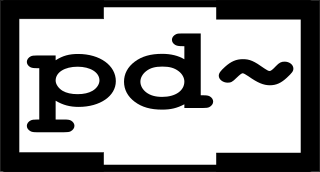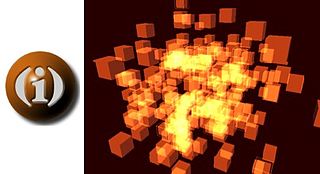Related Research Articles
Computer music is the application of computing technology in music composition, to help human composers create new music or to have computers independently create music, such as with algorithmic composition programs. It includes the theory and application of new and existing computer software technologies and basic aspects of music, such as sound synthesis, digital signal processing, sound design, sonic diffusion, acoustics, electrical engineering, and psychoacoustics. The field of computer music can trace its roots back to the origins of electronic music, and the first experiments and innovations with electronic instruments at the turn of the 20th century.
Csound is a domain-specific computer programming language for audio programming. It is called Csound because it is written in C, as opposed to some of its predecessors.
SuperCollider is an environment and programming language originally released in 1996 by James McCartney for real-time audio synthesis and algorithmic composition.
Real-Time Cmix (RTcmix) is one of the MUSIC-N family of computer music programming languages. RTcmix is descended from the MIX program developed by Paul Lansky at Princeton University in 1978 to perform algorithmic composition using digital audio soundfiles on an IBM 3031 mainframe computer. After synthesis functions were added, the program was renamed Cmix in the 1980s. Real-time capability was added by David Topper, John Gibson, Brad Garton, and Douglas Scott in the mid-1990s. In addition, support for TCP socket connectivity, interactive control of the scheduler were added, as well as the ability to embed the synthesis engine into fully featured applications such as Max/MSP.
MUSIC-N refers to a family of computer music programs and programming languages descended from or influenced by MUSIC, a program written by Max Mathews in 1957 at Bell Labs. MUSIC was the first computer program for generating digital audio waveforms through direct synthesis. It was one of the first programs for making music on a digital computer, and was certainly the first program to gain wide acceptance in the music research community as viable for that task. The world's first computer-controlled music was generated in Australia by programmer Geoff Hill on the CSIRAC computer which was designed and built by Trevor Pearcey and Maston Beard. However, CSIRAC produced sound by sending raw pulses to the speaker, it did not produce standard digital audio with PCM samples, like the MUSIC-series of programs.

Max, also known as Max/MSP/Jitter, is a visual programming language for music and multimedia developed and maintained by San Francisco-based software company Cycling '74. Over its more than thirty-year history, it has been used by composers, performers, software designers, researchers, and artists to create recordings, performances, and installations.
Algorithmic composition is the technique of using algorithms to create music.

Pure Data (Pd) is a visual programming language developed by Miller Puckette in the 1990s for creating interactive computer music and multimedia works. While Puckette is the main author of the program, Pd is an open-source project with a large developer base working on new extensions. It is released under BSD-3-Clause. It runs on Linux, MacOS, iOS, Android and Windows. Ports exist for FreeBSD and IRIX.
The Hierarchical Music Specification Language (HMSL) is a music programming language written in the 1980s by Larry Polansky, Phil Burk, and David Rosenboom at Mills College. Written on top of Forth, it allowed for the creation of real-time interactive music performance systems, algorithmic composition software, and any other kind of program that requires a high degree of musical informatics. It was distributed by Frog Peak Music, and runs with a very light memory footprint on Macintosh and Amiga systems.

In computing, a visual programming language, also known as diagrammatic programming, graphical programming or block coding, is a programming language that lets users create programs by manipulating program elements graphically rather than by specifying them textually. A VPL allows programming with visual expressions, spatial arrangements of text and graphic symbols, used either as elements of syntax or secondary notation. For example, many VPLs are based on the idea of "boxes and arrows", where boxes or other screen objects are treated as entities, connected by arrows, lines or arcs which represent relations.

Live coding, sometimes referred to as on-the-fly programming, just in time programming and conversational programming, makes programming an integral part of the running program.
Reaktor is a graphical modular software music studio developed by Native Instruments (NI). It allows musicians and sound specialists to design and build their own instruments, samplers, effects and sound design tools. It is supplied with many ready-to-use instruments and effects, from emulations of classic synthesizers to futuristic sound design tools. In addition, more than 3000 free instruments can be downloaded from the growing User Library. All of Reaktor's instruments can be freely examined, customized, or taken apart; Reaktor is a tool that effectively encourages reverse engineering. The free, limited version called Reaktor Player is a software that allows musicians to play NI-released Reaktor instruments, but not edit or reverse-engineer them.
FAUST is a domain-specific purely functional programming language for implementing signal processing algorithms in the form of libraries, audio plug-ins, or standalone applications. A FAUST program denotes a signal processor: a mathematical function that is applied to some input signal and then fed out.
MPEG-4 Structured Audio is an ISO/IEC standard for describing sound. It was published as subpart 5 of MPEG-4 Part 3 in 1999.
Kyma is a visual programming language for sound design used by musicians, researchers, and sound designers. In Kyma, a user programs a multiprocessor digital signal processor (DSP) by graphically connecting modules on the display of a Macintosh or Windows computer.
The following outline is provided as an overview of and topical guide to computer programming:

Cycling '74 is an American software development company founded in 1997 by David Zicarelli, headquartered in San Francisco, California and owned by Ableton. The company employs the digital signal processing software tool, Max.

Impromptu is a Mac OS X programming environment for live coding. Impromptu is built around the Scheme language, which is a member of the Lisp family of languages. The source code of its core has been opened as the Extempore project.